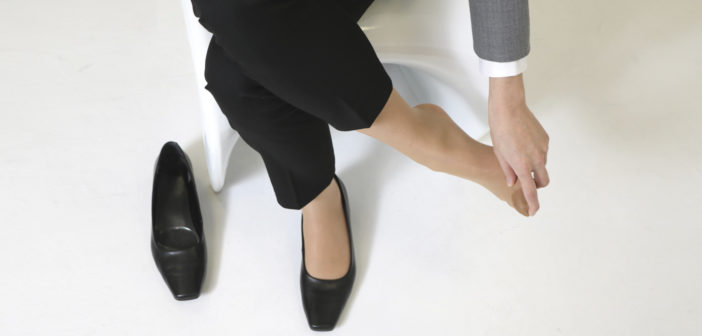Foot and ankle pain may have a variety of causes. However, a great deal of this discomfort can be improved or completely eliminated by wearing properly-fitting shoes. Finding well-fitting shoes seems like a simple thing, but many shoes are not shaped for your individual foot. As we age, wearing shoes that offer stability and allow optimal mobility without pain becomes more important.
Buy the Right Size
Many people are convinced that they wear a particular shoe size. Over the years, your foot will get wider and longer. In addition to foot size increasing over time, sizes vary greatly among different shoe manufacturers. Many companies outsource product manufacture to different facilities, so shoe sizes found within a company’s product line are not always standardized. The size printed on a shoe should serve as a guideline and not an absolute rule. You may be a size 10 in athletic shoes, a size 9 in sandals and a size 8 ½ in dress shoes. Size should NOT determine the fit – the fit should determine your size.
Be Careful with Cheap Shoes
Buy high-quality shoes from a professional shoe store. Some folks have no problem wearing discount store shoes; however, if you have foot problems, high-quality shoes are a must. Discount shoes are often made of synthetic materials that do not “breathe” well and the cushioning and support of a discount shoe will deteriorate quickly. As you age, the fat pad on the bottom of your foot gets thinner. Therefore, the cushioning in a shoe is important to reduce pain. While you’re awake, you depend on your feet for nearly everything. When your feet hurt, you hurt all over. Wearing high-quality, well-fitting shoes can make a world of difference.
What about High Heels?
Contrary to popular belief, high heels do not cause bunions, hammertoes or other problems. But, they do make foot problems more painful. It’s okay to wear high heels occasionally, but you will be much more comfortable in a shoe without a heel. Elevating the heel puts your body in an unnatural position. Force is placed across the ball of your foot as your toes are pressed into the toe box. In addition, your whole body is pitched forward, which must be compensated by bending your back; this can lead to low back pain. Finally, heels offer no shock absorption so your joints, ligaments and muscles feel the full force of walking.
Tips for Purchasing Shoes:
- Determine the type of shoe you need. If you participate in a specific sport or activity three or more times per week, you should buy a shoe dedicated to that activity.
- Locate a reputable, professional shoe store with a knowledgeable staff.
- Bring your old shoes with you when you shop – they give valuable information about wear pattern and fit.
- Visit the shoe store at the end of the day or after a workout. Bring socks and any shoe inserts or orthotic devices you typically wear.
- The length of the shoe should allow at least a thumb’s width from your longest toe to the end of the shoe.
- You should never have to “break-in” shoes – they should be comfortable when you first wear them.
As we age and our bodies change, wearing shoes that offer stability and allow optimal mobility without pain becomes more important.














